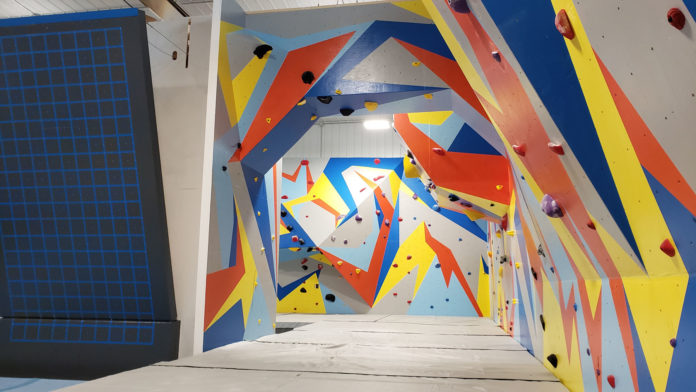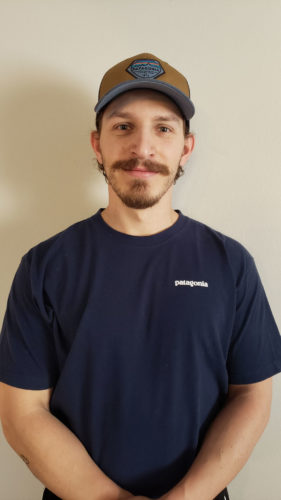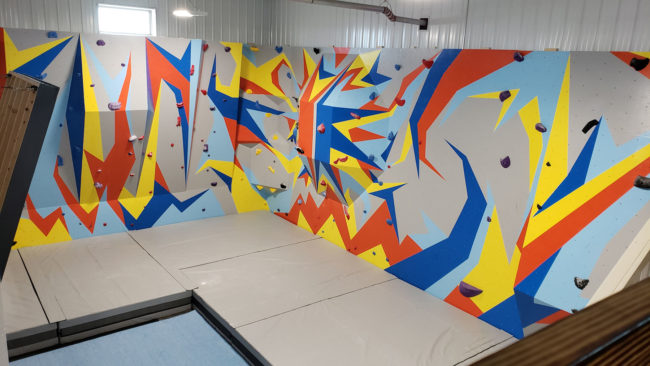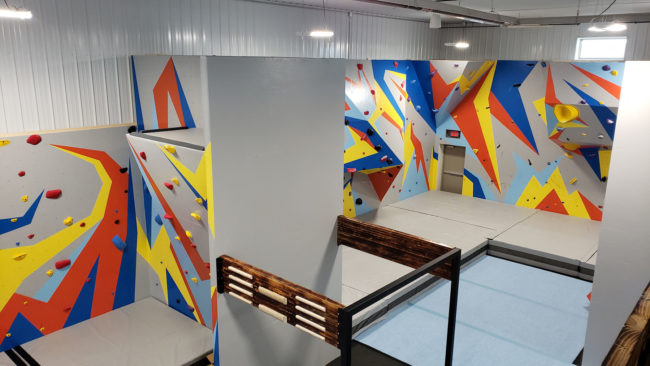
When the Coronavirus (COVID-19) crisis hit, the climbing industry was rightly quick to report on the widespread gym closures. A vast majority of the gyms in the United States and Canada, deemed non-essential businesses, were forced to temporarily cease operations in order to help slow the virus’ spread. After a few months, beginning in early May, those myriad closed gyms began to reopen. But lost amid that shift was another important category: gyms whose grand openings were scheduled to happen right around the time the pandemic was in full-force.
Climberz, a bouldering-only facility in Tea, South Dakota, was one such gym. Now, months after it was originally scheduled to have its public unveiling, Climberz went forward with its opening—making it perhaps the first new climbing gym to open while Coronavirus remains a threat. But any news announcement about the gym’s opening doesn’t tell the full story, so CBJ sat down with Climberz’ owner Travis Klinghagen to get more details about founding a gym amid a global pandemic.

CBJ: You’re one of the first climbing gyms—if not the first—to open in this new era, whether we want to call it a “pandemic period” or a “post-pandemic period.” Suffice to say, things are different now.
Klinghagen: Yeah, we were planning to open in the beginning of April. But when this all hit, we had to postpone everything and kind of wait it out. Luckily, in South Dakota, we don’t have the greatest numbers of cases, so everything is a little more free and open right now. Everything is kind of going back to—I wouldn’t say “normal,” but we’re trying to get through as best we can.
CBJ: When you say you had to “postpone everything,” what did that entail?
Klinghagen: We had already signed our lease, and we had already started construction. All that was underway. So we had to talk with our landlord. Fortunately, he worked with us and basically allowed us to continue construction and defer our payments until a later time. So that really helped us out.
The delay gave us enough time to do things that we wanted to do but maybe wouldn’t have been able to do because we were on a short timeline for construction. So, the postponement actually gave us a little more breathing room to finish some things that we really wanted to do. We added some square footage to our facility and actually made it a better gym. It was unfortunate that we couldn’t open exactly when we wanted to, but I think it worked out. There’s kind of a silver lining there. The way that our gym is, we don’t have a huge staff, and we don’t have a huge management team. It’s basically just me and my father. We were doing all of the construction.

CBJ: Was there ever a time during the pandemic crisis and the spread when you were thinking that you’d be forced to scrap the idea of opening a gym altogether?
Klinghagen: At the beginning, it was very confusing. It still is confusing. It’s a hard time to figure out what to do—and what the right thing to do is. When the pandemic first hit, we didn’t know how long it was going to be, and I couldn’t just hold off on opening indefinitely. It was definitely stressful, but I never really thought that we wouldn’t get through it. I always thought we would find a way to get this to work in some form or fashion. I talked with people and other gym owners—and the people who I am working with, my landlord. We kept the lines of communication open. As long as I did that, it felt like we were all in it together instead of just me freaking out by myself.
CBJ: When did you first start working on the gym?
Klinghagen: If we’re talking about our opening in June 2020, that would be a three-year-long endeavor. And it morphed into a bunch of different versions over that time. When I first got the idea to open a climbing gym, it was going on a bigger-scale version where we would need bank financing. Over time, we just kind of picked away at that initial idea. We actually did get bank financing eventually, but we chose to do a different route. We chose to not go with any financing and just open a smaller version [4,100-square-feet] of a bouldering facility. That’s what we will start off with, and we can then build that into bigger spaces and some different types of climbing.
CBJ: I can’t help but wonder how things might have been different if this pandemic had hit and you had stayed with your bigger plan—with significant bank financing and whatnot.
Klinghagen: If things had transpired the same way but we had started the process at a bigger version—where we needed financing—I don’t know, it’s kind of hard to speculate how things would have turned out. But I’m sure construction would have completely halted. As it turned out, we were still able to come in here every day—because it was just me and my dad—and work on it. Since I couldn’t really work at my other job [as a sports performance trainer] during this time, the gym construction was a nice outlet for staying busy and moving forward during the uncertain time.
CBJ: It’s interesting to think about how this pandemic might influence other new climbing gym owners in the future, especially regarding factors such as facility size.
Klinghagen: Yeah, it is interesting. I think people—especially now—are going to want to get out and experience new activities. This is an activity in our area that very few people have been exposed to. So, our square footage isn’t huge, but getting people exposed to climbing here might lead them to something new. We had to look at why we were opening a gym. And the reason was to build a climbing community and help the community, instead of thinking about bringing a huge, flashy facility into the area. If we do grow into a bigger facility someday so that we can build a bigger community, that would be great. But we had to start somewhere and we thought this was the most sensible way to do that.

CBJ: Have you instituted any mitigation protocols or guidelines, similar to what a lot of the reopened gyms have rolled out?
Klinghagen: I think for us to battle this properly is just to use our heads and be as sensible as possible. All of our routes have been spaced apart more than they normally would be. They’re like zones. We’re going to recommend that everyone who comes in washes their hands. And another line of defense that I’ve been talking to other people about is liquid chalk. We’re only going to be using liquid chalk, and our chalk supplier for that is 8b+. Also, our capacity is going to be at 50 percent instead of all-out. We don’t have any plans to do any reservations or anything like that, but as long as we feel like the spacing between people is adequate, we’ll roll with the punches.
I also have a cleaner—my maintenance guy has this product that is able to mist over the whole facility. We use a cordless paint sprayer to mist it on the whole wall. We do that every night.
CBJ: Is that a proprietary cleaner that your maintenance person made?
Klinghagen: He found it through one of his suppliers in California. It ended up here and he thought it’d be a great fit for us. It’s called Bioesque. It’s an all-natural formula and it doesn’t need to be wiped off at all; you can just spray it and leave it. It doesn’t build up any residue. Since it’s plant-based, it’s friendly for everyone who is in the gym. It’s a pretty solid option for us.
CBJ: How did you land on June 1st as the new opening date?
Klinghagen: By the beginning of May, businesses in our area were being allowed to open up. But we decided to wait a little longer just to see where things were headed. From my knowledge, things are kind of in a controlled situation here in the Sioux Falls area—the health system is able to handle what is going on. We are not out of control. June seemed like a time where…if people decided they wanted to come climb and partake in it, we could be open for them. As long as we are being smart with it, we thought it would be an OK option for an opening date.
CBJ: The concept of businesses reopening has been polarizing around the country. How have the people in your community responded to news that you’re opening?
Klinghagen: So far, the response has been positive. I haven’t had anyone here have any problems with it. I’m sure there are people—it’s a confusing time. I can’t speculate on the future or how things will unfold. As long as we’re being respectful of people, I think we’re making the right decision in opening. I’m not asking people to go out of their way to come and climb; we have a facility that is ready, and we’re going to keep it as clean as possible—so if people feel comfortable about that, we’ll be here for them.

John Burgman is the author of High Drama, a book that chronicles the history of American competition climbing. He is a Fulbright journalism grant recipient and a former magazine editor. He holds a master’s degree from New York University and bachelor’s degree from Miami University. In addition to writing, he coaches a youth bouldering team. Follow him on Twitter @John_Burgman and Instagram @jbclimbs. Read our interview Meet John Burgman, U.S. Comp Climbing’s Top Journalist.









